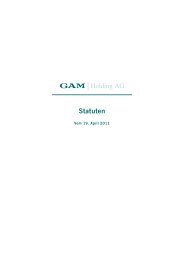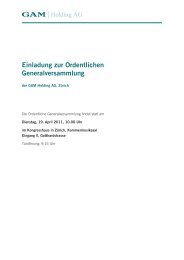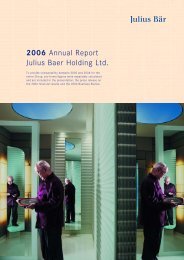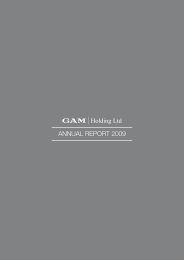2005 Annual Report Julius Baer Holding Ltd. - GAM Holding AG
2005 Annual Report Julius Baer Holding Ltd. - GAM Holding AG
2005 Annual Report Julius Baer Holding Ltd. - GAM Holding AG
You also want an ePaper? Increase the reach of your titles
YUMPU automatically turns print PDFs into web optimized ePapers that Google loves.
Notes<br />
The following methods are used in calculating calculating the estimated estimated fair fair value of of financial instruments1 instruments in the balance sheet:<br />
1 in the balance sheet:<br />
Short-term financial instruments<br />
Financial instruments with a maturity or a refinancing profile of one year or less are generally classified as short-term. This includes<br />
the balance sheet items cash and money market instruments. Depending on the maturity, it also includes the following: due from<br />
banks; due from customers; mortgages; due to banks; due to customers in savings and investment accounts; due to customers,<br />
other; cash bonds and bonds. For short-term financial instruments which do not have a market price published by a recognized<br />
stock exchange or notable market (referred to hereinafter as a market price), the book value fundamentally approximates the<br />
market value.<br />
Long-term financial instruments<br />
Depending on the maturity, these include the following balance sheet items: due from banks; due from customers; mortgages; due<br />
to banks; due to customers, other; cash bonds and bonds. The fair value of long-term financial instruments, which have a maturity<br />
or a refinancing profile of more than one year, is derived by using the net present-value method.<br />
Trading securities and financial investments<br />
For the majority of the financial instruments in the securities trading portfolio and in the financial investments as well as for the<br />
entire precious metal trading portfolio (see Notes 11 and 12), the fair value corresponds to the market price. The fair value of<br />
instruments without a market price is derived by using generally accepted valuation methods.<br />
Derivative financial instruments<br />
The fair value of the derivative financial instruments is derived primarily by using uniform models. The market price is used for<br />
derivative instruments which have one.<br />
The table does not reflect the fair values of non-financial assets and liabilities such as investments in associates, property, equipment,<br />
intangible assets and accruals.<br />
1 Compare to IAS 32, Financial Instruments: Disclosure and Presentation<br />
120 JULIUS BAER GROUP












